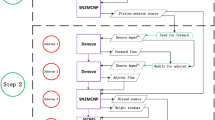Abstract
On-the-fly Doppler broadening of cross sections is important in Monte Carlo simulations, particularly in Monte Carlo neutronics-thermal hydraulics coupling simulations. Methods such as Target Motion Sampling (TMS) and windowed multipole as well as a method based on regression models have been developed to solve this problem. However, these methods have limitations such as the need for a cross section in an ACE format at a given temperature or a limited application energy range. In this study, a new on-the-fly Doppler broadening method based on a Back Propagation (BP) neural network, called hybrid windowed networks (HWN), is proposed to resolve the resonance energy range. In the HWN method, the resolved resonance energy range is divided into windows to guarantee an even distribution of resonance peaks. BP networks with specially designed structures and training parameters are trained to evaluate the cross section at a base temperature and the broadening coefficient. The HWN method is implemented in the Reactor Monte Carlo (RMC) code, and the microscopic cross sections and macroscopic results are compared. The results show that the HWN method can reduce the memory requirement for cross-sectional data by approximately 65%; moreover, it can generate keff, power distribution, and energy spectrum results with acceptable accuracy and a limited increase in the calculation time. The feasibility and effectiveness of the proposed HWN method are thus demonstrated.







Similar content being viewed by others
References
B. Forget, S. Xu, K. Smith, Direct Doppler broadening in Monte Carlo simulations using the multipole representation. Ann. Nucl. Energy 64, 78–85 (2014). https://doi.org/10.1016/j.anucene.2013.09.043
K. Wang, S. Liu, Z. Li et al., Analysis of BEAVRS two-cycle benchmark using RMC based on full core detailed model. Prog. Nucl. Energ. 98, 301–312 (2017). https://doi.org/10.1016/j.pnucene.2017.04.009
T. Viitanen, J. Leppänen, Effect of the target motion sampling temperature treatment method on the statistics and performance. Ann. Nucl. Energy 82, 217–225 (2015). https://doi.org/10.1016/j.anucene.2014.08.033
J. Leppänen, M. Pusa, T. Viitanen et al., The serpent Monte Carlo code: status, development and applications in 2013. Ann. Nucl. Energy 82, 142–150 (2015). https://doi.org/10.1016/j.anucene.2014.08.024
C. Josey, B. Forget, K. Smith. Efficiency and accuracy evaluation of the windowed multipole direct Doppler baradening method.in PHYSOR 2014, The Westin Miyako, Kyoto, Japan (2014).
G. Yesilyurt, W.R. Martin, F.B. Brown et al., On-the-fly Doppler broadening for Monte Carlo Codes. Nucl. Sci. Eng. 171, 239–257 (2012). https://doi.org/10.13182/NSE11-67
J.A. Walsh, B. Forget, K.S. Smith et al., On-the-fly Doppler broadening of unresolved resonance region cross sections. Prog. Nucl. Energy 101, 444–460 (2017). https://doi.org/10.1016/j.pnucene.2017.05.032
A.T. Pavlou, W. Ji, On-the-fly sampling of temperature-dependent thermal neutron scattering data for Monte Carlo simulations. Ann. Nucl. Energy 71, 411–426 (2014). https://doi.org/10.1016/j.anucene.2014.04.028
S. Liu, Y. Yuan, J. Yu et al., Development of on-the-fly temperature-dependent cross sections treatment in RMC code. Ann. Nucl. Energy 94, 144–149 (2016). https://doi.org/10.1016/j.anucene.2016.02.026
S. Liu, X. Peng, C. Josey et al., Generation of the windowed multipole resonance data using vector fitting technique. Ann. Nucl. Energy 112, 30–41 (2018). https://doi.org/10.1016/j.anucene.2017.09.042
X. Liu, L. Deng, Z. Hu et al., Study of on-the-fly Doppler broadening in JMCT program. Acta Phys. Sin. 65, 42–47 (2016). https://doi.org/10.7498/aps.65.092501
E.R. Caianiello, Mathematical theory of neural networks. IFAC Proc. Vol. 2, 395–397 (1968). https://doi.org/10.1016/S1474-6670(17)68880-3
F. Cao, K. Yao, J. Liang, Deconvolutional neural network for image super-resolution. Neural Netw. 132, 394–404 (2020). https://doi.org/10.1016/j.neunet.2020.09.017
H. Heo, B. So, I. Yang et al., Automated recovery of damaged audio files using deep neural networks. Digit. Invest. 30, 117–126 (2019). https://doi.org/10.1016/j.diin.2019.07.007
Y. Li, J. Li, J. Huang et al., Fitting analysis and research of measured data of SAW micro-pressure sensor based on BP neural network. Measurement 155, 107533 (2020). https://doi.org/10.1016/j.measurement.2020.107533
S. Zare, M. Ayati, Simultaneous fault diagnosis of wind turbine using multichannel convolutional neural networks. ISA Trans. 108, 230–239 (2021). https://doi.org/10.1016/j.isatra.2020.08.021
R. Pahič, B. Ridge, A. Gams et al., Training of deep neural networks for the generation of dynamic movement primitives. Neural Netw. 127, 121–131 (2020). https://doi.org/10.1016/j.neunet.2020.04.010
D.E. Rumelhart, G.E. Hinton, R.J. Williams, Learning representations by back-propagating errors. Nature 323, 533–536 (1986). https://doi.org/10.1038/323533a0
P.S. Kumar, H.S. Behera, K.K. Anisha et al., Advancement from neural networks to deep learning in software effort estimation: perspective of two decades. Comp. Sci. Rev. 38, 100288 (2020). https://doi.org/10.1016/j.cosrev.2020.100288
K. Wang, Z. Li, D. She et al., RMC – A Monte Carlo code for reactor core analysis. Ann. Nucl. Energy 82, 121–129 (2015). https://doi.org/10.1016/j.anucene.2014.08.048
R.E. MacFarlane, A.C. Kahler, Methods for processing ENDF/B-VII with NJOY. Nucl. Data Sheets 111, 2739–2890 (2010). https://doi.org/10.1016/j.nds.2010.11.001
Author information
Authors and Affiliations
Contributions
All authors contributed to the study conception and design. Data collection and analysis were performed by Tian-Yi Huang and Ze-Guang Li. The programming and tests are strongly supported by Kan Wang, Xiao-Yu Guo and Jin-Gang Liang. The first draft of the manuscript was written by Tian-Yi Huang and all authors commented on previous versions of the manuscript. All authors read and approved the final manuscript.
Corresponding author
Additional information
This work was supported by the Science Challenge Project (No. TZ2018001), the National Natural Science Foundation of China (Nos. 11775126, 11545013, 11775127), Young Elite Scientists Sponsorship Program by CAST (No. 2016QNRC001), and Tsinghua University Initiative Scientific Research Program.
Rights and permissions
About this article
Cite this article
Huang, TY., Li, ZG., Wang, K. et al. Hybrid windowed networks for on-the-fly Doppler broadening in RMC code. NUCL SCI TECH 32, 62 (2021). https://doi.org/10.1007/s41365-021-00901-2
Received:
Revised:
Accepted:
Published:
DOI: https://doi.org/10.1007/s41365-021-00901-2




